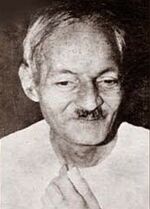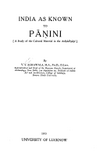Vasudeva Saran Agrawala

Vasudeva Saran Agrawala (b.7 August 1904- d.27 July 1966) from Pilakhua, a village in the Meerut district, Uttar Pradesh was one of the great scholar of the present century who specialized in several disciplines and areas of Indology including Ancient and Mediaeval Indian literature, History, Culture, Art and archaeology.
India as Known to Panini

Book: V. S. Agrawala: India as Known to Panini, 1953
For his research degrees he made a Cultural study of Panini's Astadhyayi under Dr. R. K. Mookerji. His researches on the Astadhyayi are contained in India as Known to Panini: a study of the cultural material in the Ashṭādhyāyī, University of Lucknow, 1953 - India - 549 pages.
Jats as known to Panini
Bhim Singh Dahiya[1] has quoted V.S. Agarwala's book India as known to Panini and has mentioned that many Saka tribes described in this book are now found among the Jats. For details see India as known to Panini. Some of these tribes include: Rishikas, Kantha, Gathwala, Vrika, Kundu, Parsawal, Maharajaki, Sahrawat, Gurlawat, Kangs etc.
संक्षिप्त जीवनी
वासुदेव शरण अग्रवाल (जन्म- 7 अगस्त, 1904, ग़ाज़ियाबाद, उत्तर प्रदेश; मृत्यु- 26 जुलाई, 1966) भारत के प्रसिद्ध विद्वानों में से एक थे। वे भारत के इतिहास, संस्कृति, कला, साहित्य और प्राच्य विद्या आदि विषयों के विशेषज्ञ थे।
वासुदेव शरण अग्रवाल 'हिन्दी विश्वकोश सम्पादक मण्डल' के प्रमुख सदस्य थे। उन्होंने मथुरा संग्रहालय (उत्तर प्रदेश) के संग्रहाध्यक्ष के रूप में अपनी सेवाएँ प्रदान की थीं। उनकी प्रसिद्ध पुस्तक 'पाणिनिकालीन भारतवर्ष' में भारत की संस्कृति, कला और साहित्य आदि पर प्रकाश डाला गया है। उन्हें साहित्य अकादमी द्वारा पुरस्कृत भी किया गया था। जन्म प्राच्य विद्या के प्रसिद्ध विद्वान डॉ. वासुदेव शरण अग्रवाल का जन्म 7 अगस्त, 1904 ई. को ग़ाज़ियाबाद (उत्तर प्रदेश) के 'खेड़ा' नामक गाँव में हुआ था। इनकी छोटी उम्र में ही इनका माँ का देहांत हो गया था, जिस कारण दादी ने ही उनका लालन-पालन किया। शिक्षा जिस समय 1920 में राष्ट्रपिता महात्मा गाँधी ने 'भारतीय इतिहास' में प्रसिद्ध अपना 'असहयोग आंदोलन' आंरभ किया, उस समय वासुदेव शरण लखनऊ में शिक्षा प्राप्त कर रहे थे। साथ ही वे एक अन्य विद्वान से संस्कृत का विशेष अध्ययन भी कर रहे थे। आंदोलन के प्रभाव से उन्होंने सरकारी विद्यालय छोड़ दिया और खादी के वस्त्र धारण कर लिए। किंतु जब गाँधीजी ने आंदोलन वापस ले लिया तो उन्होंने फिर औपचारिक शिक्षा आरंभ की और 'काशी हिन्दू विश्वविद्यालय' से स्नातक बन कर एम.ए और एलएल. बी. की शिक्षा के लिए लखनऊ आ गए। आगे चलकर इसी विश्वविद्यालय से उन्हें पी.एच.डी. और डी.लिट की उपाधियाँ मिलीं। कृतियाँ
वासुदेव शरण अग्रवाल भारत के इतिहास, संस्कृति, कला एवं साहित्य के विद्वान थे। वे 'साहित्य अकादमी' द्वारा पुरस्कृत हिन्दी गद्यकार थे। 'पाणिनिकालीन भारतवर्ष' नामक उनकी कृति भारतविद्या का अनुपम ग्रन्थ है। इसमें उन्होंने पाणिनि के 'अष्टाध्यायी' के माध्यम से भारत की संस्कृति एवं जीवन दर्शन पर प्रकाश डाला है। उन्होंने साहित्य के सहारे भारत का पुन: अनुसंधान किया है, जिसमें उन्होंने वैज्ञानिक एवं तर्कपूर्ण विधि का प्रयोग किया है। उनकी निम्नलिखित कृतियाँ भी बहुत प्रसिद्ध हैं- "मलिक मुहम्मद जायसी - पद्मावत" "हर्षचरित - एक सांस्कृतिक अध्ययन" वासुदेव शरण अग्रवाल 'हिन्दी विश्वकोश' के सम्पादक-मण्डल के प्रमुख सदस्य थे। उच्च पदों पर कार्य वासुदेव शरण अग्रवाल ने उत्तर प्रदेश में 'मथुरा संग्रहालय' के क्यूरेटर (संग्रहाध्यक्ष) के रूप में भी अपनी सेवाएँ प्रदान की थीं। वे लखनऊ के प्रांतीय संग्रहालय के भी क्यूरेटर रहे। स्वतंत्रता के बाद दिल्ली में स्थापित 'राष्ट्रीय पुरातत्त्व संग्रहालय' की स्थापना में इनका प्रमुख योगदान था। छह वर्ष तक दिल्ली में रहने के उपरांत वे 'काशी हिन्दू विश्वविद्यालय' के 'भारतीय विद्या संस्थान' के प्रमुख बनकर वाराणसी चले गए। 1951 से 1966 तक जीवन पर्यंत वे इस पद पर रहे। पंद्रह वर्षों के इस कार्यकाल में उन्होंने वेद, उपनिषद, पुराण, महाभारत, काव्य साहित्य सृजित किया। वह अपने क्षेत्र में युग निर्माणकारी माने जाते हैं। फुटकर निबंधों के अतिरिक्त इन विषयों पर उन्होंने हिन्दी में लगभग 36 और अंग्रेजी में 23 ग्रंथों की रचना की थी। इनमें वेद विद्या संबंधी ग्रंथ हैं, पुराणों का अध्ययन है, महाभारत की सांस्कृतिक मीमांसा है, 'मेघदूत', 'कादम्बरी', 'पद्मावत' जैसे ग्रंथों की व्याख्या है। अपने इस विशेष योगदान के कारण उनका विद्वानों में और साधारण पाठकों दोनों में बड़ा सम्मान था। निधन वासुदेव शरण अग्रवाल का निधन 26 जुलाई, 1966 को हुआ।
साभार - भारतकोष - http://bharatdiscovery.org/india/वासुदेव_शरण_अग्रवाल
On Jat History
Shaka clan - वी० एस० अग्रवाल ने “इण्डिया अज़् नोन् टु पाणिनि पृ० 68-69” पुस्तक का हवाला देकर लिखा है कि “बहुत से शक कबीले (जातियां) आज भी जाटों में पाये जाते हैं। शक लोग पाणिनि ऋषि के समय से पहले भारतवर्ष में आये और इनकी दूसरी लहर दूसरी शताब्दी ईस्वी पूर्व में भारत में आई और इसके पश्चात् कुषाण लोग आये। मध्य एशिया के शक लोगों ने वापी या रहट (Stepped Well) तथा अरघट्टा (Persian wheel) का निर्माण किया। स्थानों या नगरों के नाम जिनके अन्त में कन्द लगता है वे सब शक लोगों ने आरम्भ किए जैसे - समरकन्द, ताशकन्द, यारकन्द आदि।”[2] [3][4]
Hala clan - Coins of a king named Ripu Salya have been found and these Coins have the fire altar on them.[5] V.S. Agrawala says, "they migrated from west through Baluchistan and Sindh, where they left traces of their name in Salvka-giri, (mentioned by Panini) the present Hala mountains; and then advancing towards north Sauvira and along the Sarasvati, finally settled in north Rajasthan.[6]
Gandas clan - In Gupta inscriptions Names of the Vithi-Mahattaras (Vithi-elders) have been mentioned. Kalaikuri Sultanpur Copper-plate Inscription of the Gupta Year 120 (=A.D. 439) mentions about Ganda as a name of Vithi-elders in Line-4. According to lexicographers Ganda means 'the chief; best, excellent' [7] and thus can signify a hero. The term is also used for the animal rhinoceros, so it can also be a case of a name based on the name of an animal. The custom of deriving names from animals was unknown in the Vedic period. [8] But in Panini we find such references. [9]
Bhim Singh Dahiya[10] provides chart of clans - In this chart many clans, e.g. Bohla, Sheoran/Sori/Sor; Khichar, Kharwal/Kharwan, Malu/Mahla, etc. have been given a double ancestry, an unavoidable result when the cart is put before the horse. Of course, we do not deny that new clans were formed or branched out from an existing clan, but a new clan branched out from an older one, generally in the form of the descendants of a particularly important member of the mother clan; it was never vice versa. Therefore, to say that Mor (Maurya) clan was a branch of the Parmars is absurd. What actually may have happened is something like this: A clan gains political ascendancy, and other clans who support the ascendant clan, become part of a political confederacy. It was in this sense that the confederacies of Mor, Sakan, Kasuan, Oujar, Parmar, Chauhan, Rathors, etc. were formed. This does not mean that the members of the particular confederacy headed by a particular clan, were descendants or branches of the later ascendant clan. Therefore, in effect, the present chart only shows that the particular Jat clans, among others, were supporters of the Tomar or Chauhan, or Bhatti or Parmar or Gujar royal families when these later formed their kingdoms. It is on account of this factor that a particular clan is seen as part of more than one ascendant clan and "the double ancestry". We are giving this chart with a view to draw attention to certain clan names, e.g. the Sakan (Sakan Sacae?) Khot (Got?) Hela (Hala? Hellenes) Rapadia (Arpad of Assyrian history, the present Tell R' fad ?). These apparent similarities with the ancient names of Asian Minor, have to be viewed in the context of many other identities given earlier regarding names of people and cities of that area and the Indian names, (see the chapter on Antiquity). We have also to explain the worship of the Babylonian goddess Nana, under the same name in the present Himachal Pradesh of India. Prof. V.S. Agrawala, has drawn our attention to the occurrence of West Asian names in Vedic literature, e.g. Taimat, Aligi-Viligi, Urugula (Athaarra Veda) Apsu (Rig Veda) Kabru (Atharva Veda). As per Satapatha Brahmana Sukra or Venus is Atta, who in the Assyrian and Aramaie inscriptions of eighth/seventh century B.C. appears as a goddess.
Arjunayana - Tej Ram Sharma[11] writes that Panini[12] refers to the worshipper of Arjuna, called Arjunaka, together with the devotee of Vasudeva, called Vasudevaka. This remark implies that Arjuna was treated as a deity at the time of Panini and his followers occupied a prominent position. [13] The Kasika replaces Auddālakayana of Patanjali by Arjunayana, [14] the name of a tribe nearer to its own time in discussing the meaning of Prachya-bharata (II.4.66).
Sandhu - Bhim Singh Dahiya[15] writes....The ancient Greeks mentioned them as Sindi (Sindicar of Herodotus) and placed them on the Basphorus. In Indian literaature they are mentioned as Sindhu or Saindhava and are associated with Sauvira-of the expression Sindhu-Sauvira. In Kurma Purana and Vishnu Purana, they are mentioned with the Hunas : "Sauvirah Saindhava Hunan". (सौवीरा सैंधवाहूणा:), as residents of Sakala, Sialkot. Panini mentions a Janapada (Repubhc) of the Sindhus between Jhelum and Indus rivers.[16] In Mahabharata war, they fought on the side of Kauravas.153 A copper plate inscription of Gujarat, Chalukiya Pulakesi Raja refers to Tajiks, i.e., Arabs who had defeated the Sandhus and other tribes in West India. Earlier, in 739 A.D., they had defeated the Arabs under their king Punyadeva. In 756 and 776 A.D., they twice repulsed the Arab naval attacks.
Agila, Satila, Nagila, Yakhila , Samghila Jat clans:
Tej Ram Sharma[17] describes some names ending in la. He mentions from Udayagiri Cave Inscription of the time of Kumaragupta I of Gupta Year 106 (=A.D. 425) a name such as Samghila, who was a soldier who has been mentioned as an 'Ashvapaty. It is an abbreviated form of the full name 'Samghadatta'. We find Agila (Agnidatta), Satila (Svatidatta), Nagila (Nagadatta), Yakhila (Yaksadatta), Samghila (Samghadatta) in Sanchi Inscriptions.[18].
External links
See also
References
- ↑ Jats the Ancient Rulers (A clan study)/The Jats,p.72-77
- ↑ Vasudeva Saran Agrawala: India as Known to Panini, 68-69
- ↑ (H.W. Bailey, ASLCA, Transaction of Philological Society, 1945, PP 22, 33)
- ↑ Jat History Dalip Singh Ahlawat/Chapter IV,p.346
- ↑ JRAS, 1901,p. 97 ff
- ↑ op. cit., p. 55
- ↑ Sanskrit-English Dictionary by Monier Williams, p. 344, col. 1.
- ↑ V.S. Agrawala, India as Known to Panini, p. 186.
- ↑ Panini, II. 1.56 :उपमितं व्यघ्रादिभि: सामान्यप्रयोगे, Cf. Panini, V. 3.81. The names of species adopted as personal names, e.g. Vyaghraka, Simhaka.
- ↑ Jats the Ancient Rulers (A clan study)/Appendices/Appendix I,p.317-318
- ↑ Personal and geographical names in the Gupta inscriptions/Tribes,p.
- ↑ Panini, IV. 3.98. V.S. Agrawala, India as Known to Panini, p. 341.
- ↑ Buddha Prakash, (Paniniya-Dhatu-Patha-Samiksa by Bhagirath Prasada Tripathi) 1 p. 93.
- ↑ V.S. Agrawala, India as Known to Panini, p. 30.
- ↑ Jats the Ancient Rulers (A clan study)/Jat Clan in India,p.269
- ↑ V. S. Agrawala, op. cit., p. 50.
- ↑ Tej Ram Sharma: Personal and geographical names in the Gupta inscriptions/Names of Local Officers,p. 67
- ↑ V S Agarwal, India as Known to Panini,p.191
Back to Jat Historians

